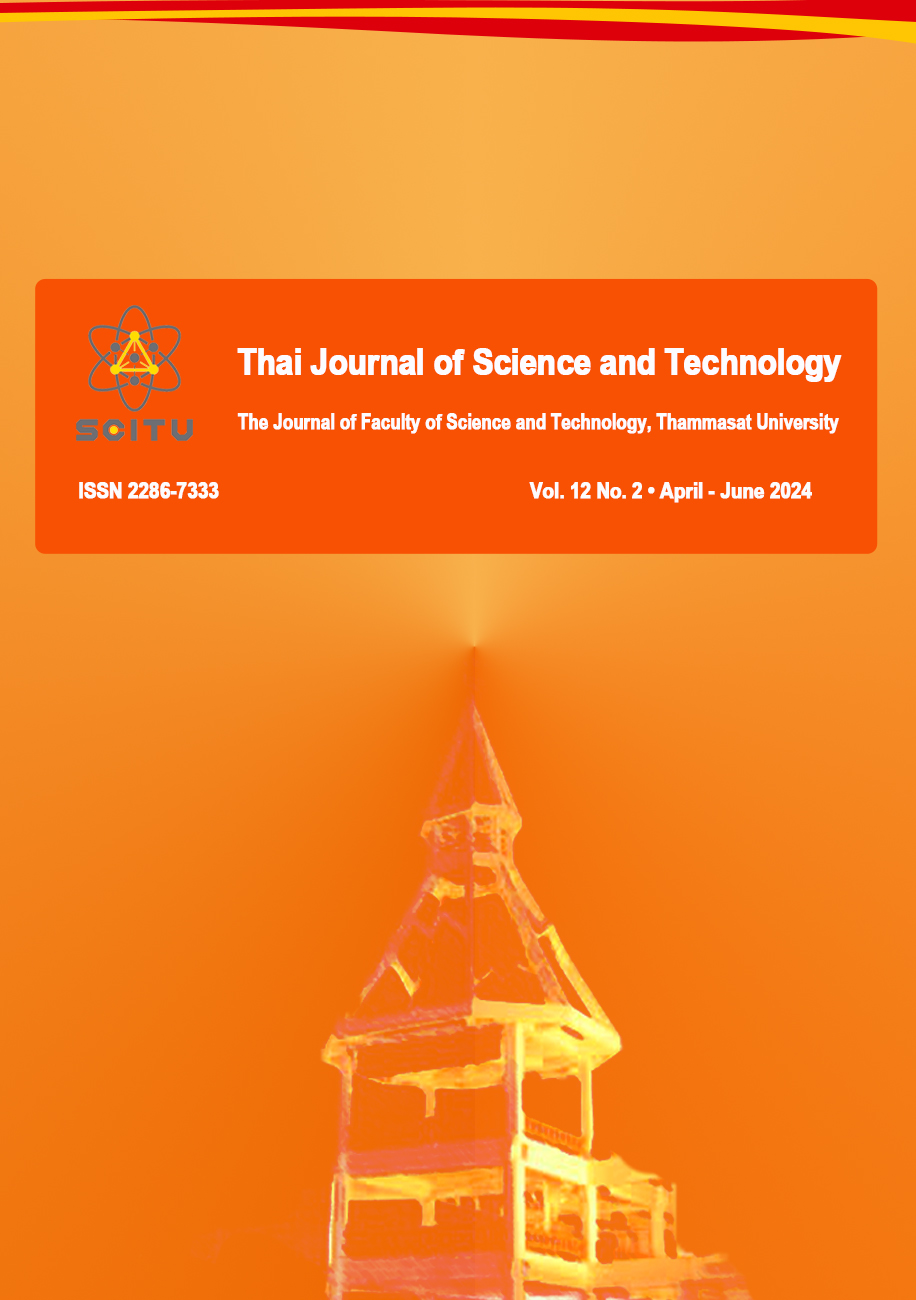การประเมินความหลากหลายและความสัมพันธ์ทางพันธุกรรมของกล้วยไม้นกคุ้มไฟ และกล้วยไม้สปีชีส์ใกล้เคียงที่พบในประเทศไทย ด้วยเครื่องหมายไอเอสเอสอาร์
Main Article Content
บทคัดย่อ
กล้วยไม้นกคุ้มไฟ (Anoecotchilus burmannicus) เป็นกล้วยไม้ดินที่มีคุณค่าเชิงสมุนไพร เนื่องจากมีถิ่นที่อยู่จำเพาะ และมีปริมาณลดลงในธรรมชาติ จึงมีการจัดพื้นที่อนุรักษ์ในเขต อ.แม่ริม จ.เชียงใหม่ แต่ยังไม่มีรายงานเกี่ยวกับความหลากหลายทางพันธุกรรมของกล้วยไม้นี้ในพื้นที่อนุรักษ์ งานวิจัยนี้มีวัตถุประสงค์เพื่อประเมินความสัมพันธ์ และความหลากหลายทางพันธุกรรมของกล้วยไม้นกคุ้มไฟในพื้นที่อนุรักษ์ และกล้วยไม้ในสกุล Anoectochilus อื่นๆ ที่รวมรวบจากพื้นที่ภาคเหนือของประเทศไทย ไพรเมอร์ของเครื่องหมาย ISSR 7 เครื่องหมายถูกนำมาสร้างลายพิมพ์ดีเอ็นเอของกล้วยไม้นกคุ้มไฟ กล้วยไม้ A. albolineatus A. roxburghii A. elwesii และ O. lanceolatus จำนวนทั้งหมด 33 ตัวอย่าง เครื่องหมายที่ใช้สามารถแยกกล้วยไม้ทั้ง 5 สปีชีส์ออกจากกัน และสามารถจัดกลุ่มได้ 2 กลุ่ม ความหลากหลายทางพันธุกรรมของนกคุ้มไฟในพื้นที่อนุรักษ์อยู่ในระดับปานกลาง โดยมีค่า Nei’s genetic diversity (H) และ Shannon’s information index (I) เท่ากับ 0.22 และ 0.33 ตามลำดับ สำหรับ A. albolineatus A. roxburghii และ A. elwesii มีค่า H และ I อยู่ในช่วง 0.12-0.15 และ 0.19-0.23 ตามลำดับ ในขณะที่ O. lanceolatus มีค่าความหลากหลายต่ำ (H=0.07, I=0.10) งานวิจัยนี้เป็นการรายงานความสัมพันธ์ทางพันธุกรรม และความหลากหลายทางพันธุกรรมของกล้วยไม้สกุล Anoectochilusในประเทศไทยเป็นครั้งแรก ความรู้ในงานวิจัยนี้อาจใช้เป็นแนวทางในการอนุรักษ์เพื่อการใช้ประโยชน์กล้วยไม้กลุ่มนี้ต่อไปได้
Article Details

อนุญาตภายใต้เงื่อนไข Creative Commons Attribution-NonCommercial-NoDerivatives 4.0 International License.
บทความที่ได้รับการตีพิมพ์เป็นลิขสิทธิ์ของคณะวิทยาศาสตร์และเทคโนโลยี มหาวิทยาลัยธรรมศาสตร์ ข้อความที่ปรากฏในแต่ละเรื่องของวารสารเล่มนี้เป็นเพียงความเห็นส่วนตัวของผู้เขียน ไม่มีความเกี่ยวข้องกับคณะวิทยาศาสตร์และเทคโนโลยี หรือคณาจารย์ท่านอื่นในมหาวิทยาลัยธรรมศาสตร์ ผู้เขียนต้องยืนยันว่าความรับผิดชอบต่อทุกข้อความที่นำเสนอไว้ในบทความของตน หากมีข้อผิดพลาดหรือความไม่ถูกต้องใด ๆ
เอกสารอ้างอิง
Abd-dada, H., Bouda, S., Khachtib, Y., Bella, Y.A., & Haddioui, A. (2023). Use of ISSR markers to assess the genetic diversity of an endemic plant of Morocco (Euphorbia resinifera O. Berg). Journal of Genetic Engineering and Biotechnology, 21(1), 91. https://doi.org/10.1186/s43141-023-00543-4
Bhattacharyya, P., Kumaria, S., & Tandon, P. (2015). Applicability of ISSR and DAMD markers for phyto-molecular characterization and association with some important biochemical traits of Dendrobium nobile, an endangered medicinal orchid. Phytochemistry, 117, 306-316. https://doi.org/https://doi.org/10.1016/j.phytochem.2015.06.022
Budluang, P., Pitchakarn, P., Ting, P., Temviriyanukul, P., Wongnoppawich, A., & Imsumran, A. (2017). Anti-inflammatory and anti-insulin resistance activities of aqueous extract from Anoectochilus burmannicus. Food Science & Nutrition, 5(3), 486-496. https://doi.org/10.1002/fsn3.416
Cai, J., Zhao, L., & Zhu, E. (2015). A new flavonol triglycoside derived from Anoectochilus elwesii on stimulating glucose uptake in insulin-induced human HepG2 cells. Natural Product Research, 29(15), 1414-1418. https://doi.org/10.1080/14786419.2014.1003135
Das, A., Kesari, V., Satyanarayana, V.M., Parida, A., & Rangan, L. (2011). Genetic relationship of Curcuma species from Northeast India using PCR-based markers. Moleculat Biotechnology, 49(1), 65-76. https://doi.org/10.1007/s12033-011-9379-5
Du, X.-M., Irino, N., Furusho, N., Hayashi, J., & Shoyama, Y. (2008). Pharmacologically active compounds in the Anoectochilus and Goodyera species. Journal of Natural Medicines, 62(2), 132-148. https://doi.org/10.1007/s11418-007-0169-0
Huang, J.C., Wan, S.Q., Chen, Y., Li, L.H., Zhang, Z.L., Zhu, J.J., Wu, M., Xing, B.C., Shao, Q.S., & Lu, C.F. (2023). Genetic diversity of Anoectochilus roxburghii based on ISSR and SRAP molecular markers. Journal of Zhejiang Agricultural and Forestry University, 40(1), 22–29. https://doi.org/10.11833/j.issn.2095-0756.20220473
Hwang, S.-K., & Kim, Y.-M. (2000). A Simple and Reliable Method for Preparation of Cross-Contamination- Free Plant Genomic DNA for PCR-Based Detection of Transgenes. Journal of Biochemistry and Molecular Biology, 33, 537-540.
Karinchai, J., Budluang, P., Temviriyanukul, P., Ting, P., Nuchuchua, O., Wongnoppavich, A., Imsumran, A., & Pitchakarn, P. (2021). Bioassay-guided study of the anti-inflammatory effect of Anoectochilus burmannicus ethanolic extract in RAW 264.7 cells. Journal of Ethnopharmacology, 280, 114452. https://doi.org/https://doi.org/10.1016/j.jep.2021.114452
Nei, M. (1973). Analysis of gene diversity in subdivided populations. Proceedings of the National Acadamy of Sciences of the United States of America, 70(12), 3321-3323. https://doi.org/10.1073/pnas.70.12.3321
Page, R.D.M. (1996). Tree View: An application to display phylogenetic trees on personal computers. Bioinformatics, 12(4), 357-358. https://doi.org/10.1093/bioinformatics/12.4.357
Parab, G.V., Krishnan, S., Janarthanam, M.K., Sivaprakash, K.R., & Parida, A. (2008). ISSR and RAPD Markers Assessed Genetic Variation of Aerides maculosum — an Epiphytic Orchid from Goa, India. Journal of Plant Biochemistry and Biotechnology, 17(1), 107-109. https://doi.org/10.1007/BF03263271
Pavlícek, A., Hrdá, S., & Flegr, J. (1999). Free-Tree--freeware program for construction of phylogenetic trees on the basis of distance data and bootstrap/jackknife analysis of the tree robustness. Application in the RAPD analysis of genus Frenkelia. Folia Biologica (Praha), 45(3), 97-99.
Peyachoknagul, S. (2009). DNA marker: from basic to application (1 ed.). Kasetsart University Press. (in Thai)
Sakulsathaporn, A., Choradet, I., & Roopkham, C. (2023). Genetic Diversity of the Endemic Species Phanera sirindhorniae in the Mekong Basin of Thailand Based on ISSR Markers. Trends in Sciences, 20(12), 7053. https://doi.org/10.48048/tis.2023.7053
Sitthisajjathum, S. (2007). Wild orchid of Thailand (3rd Edition ed.). Baanlaesuan. (in Thai)
Sukjit, S., Sakulsingharoj, C., Nonthasawatsri, C., & Khemkladngoen, N. (2019). Application of Inter-Simple Sequence Repeat (ISSR) Markers for Verification of Interspecific Hybrids between Paracurcuma and Eucurcuma. Thai Journal of Science and Technology, 8(3), 287-299. https://doi.org/https://doi.org/10.14456/tjst.2019.37 (in Thai)
Taheri, S., Abdullah, T.L., Abdullah, N.A., & Ahmad, Z. (2012). Genetic relationships among five varieties of Curcuma alismatifolia (Zingiberaceae) based on ISSR markers. Genetics and Molecular Research, 11(3), 3069-3076. https://doi.org/10.4238/2012.August.31.4
Tran, T.H.I., Pham, M., Huong, T., Widiarsih, S., & Ho, V.T. (2022). Investigation of the genetic diversity of jewel orchid in Vietnam using RAPD and ISSR markers. Biodiversitas Journal of Biological Diversity, 23(9), 4816-4825. https://doi.org/10.13057/biodiv/d230950
Ueno, S., Rodrigues, J.F., Alves-Pereira, A., Pansarin, E.R., & Veasey, E.A. (2015). Genetic variability within and among populations of an invasive, exotic orchid. AoB PLANTS, 7. https://doi.org/10.1093/aobpla/plv077
Yang, Y., Tang, J., Zou, R., Luo, Y., Deng, Z., Li, D., Chai, S., & Wei, X. (2023). The Genetic Diversity and Genetic Structure of the Germplasm Resources of the Medicinal Orchid Plant Habenaria dentata. Genes, 14(9), 1749. https://www.mdpi.com/2073-4425/14/9/1749
Ye, S., Shao, Q., & Zhang, A. (2017). Anoectochilus roxburghii: A review of its phytochemistry, pharmacology, and clinical applications. Journal of Ethnopharmacology, 209, 184-202. https://doi.org/10.1016/j.jep.2017.07.032
Zhang, F., Lv, Y., Dong, H., & Guo, S. (2010). Analysis of Genetic Stability through Intersimple Sequence Repeats Molecular Markers in Micropropagated Plantlets of Anoectochilus formosanus HAYATA, a Medicinal Plant. Biological & pharmaceutical bulletin, 33, 384-388. https://doi.org/10.1248/bpb.33.384


